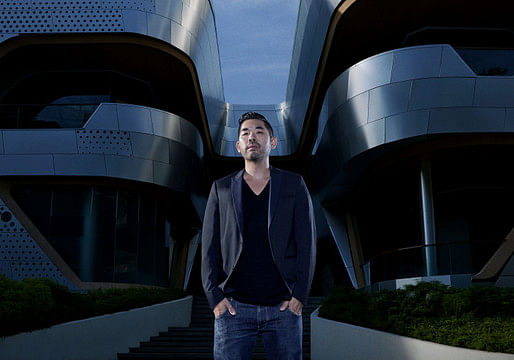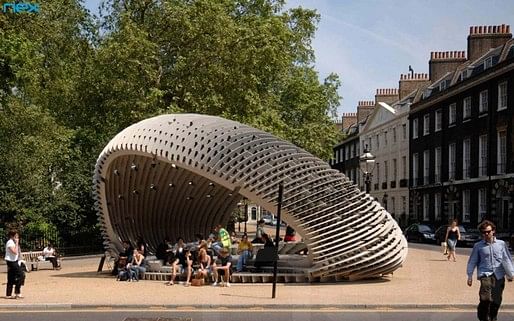

On Monday, Modelo interviewed Synthesis Design + Architecture founder Alvin Huang. SDA is a growing Los Angeles-based firm with a global reach working on projects that range from actual buildings, to furniture, to public art and physical products.
On SDA’s approach to design:
The bottom line is that we are designers and we like to think laterally and think about design problems. Very recently we’ve been motivated by this quote I found in a lecture by Cedric Price in the 1960s, “Technology is the answer, but what is the question?” That’s the way we approach things. We’re highly technologically driven but technology is the means, not the ends. We use technology as an opportunity to ask ourselves very specific questions about design problems.There’s a difference between research being the collection of knowledge and the collection of information, and research that’s about the production of information and production of knowledge. We’re interested in design that can produce knowledge and information…
On research as part of the design process:
We use research as a form of design and design as a form of research. They’re clearly overlapping and there’s a distinct difference between research in a traditional architectural sense where everybody will say do research for every project. There’s a difference between research being the collection of knowledge and the collection of information and research that’s about the production of information and production of knowledge. We’re interested in design that can produce knowledge and information, and I think in that sense it’s very clearly related to my own academic interests at USC.

Synthesis Design & Architecture, Los Angeles
Also in terms of computational design practice, it is something that has evolved from its initial states in the 80’s as a pure tool which was just about design production and then in the 90’s became entirely about design technique which was mostly about novelty . We’re now in what I would call a post-digital era where the digital is a given and continues to impact both design production and design technique, but now also is critical in defining the design intuitions we bring to the table and the design information we are able to produce. Computational design research has become a form of industrial R&D. Craft now is something that isn’t only how materials go together but also in terms how to assemble a 3D model and how to produce a file for 3D printing. It’s very clear craft-based skill sets that have a very clear reciprocal relationship with the physical artifact.
On his most used software:
We’re very polygamist when it comes to software. We use pretty much everything that’s out there, primarily through Rhino, we’re bouncing between Rhino, Maya, 3ds Max though mostly through Rhino. We use the entire zoo of plug-ins for Rhino… kangaroo, ladybug, everything. We’re definitely omnivores. There’s always the right tool for the right jobs, there’s never a do-it-all thing. We like multi-platform tools that exchange really well across different entities.
On team project collaboration:
That’s one of the things that helps about being a small firm. We do a lot of file exchange through our server, we sit next to each other and talk a lot. Very old fashioned. As designers we’re part curator and creator, but more than anything, we are moderators of a discussion. As moderators, we identify what the topic is and how to talk about it. The end results come out of that conversation between us, our clients, our fabricators our consultants all the user and interest groups involved in the project. We do a lot of conference calls with clients from all over the world: Los Angeles, Israel, China, Texas and will most often exchange through screen sharing. In that scenario the ability to in real-time view and navigate a model is really useful. Right now, we aren’t using anything like Modelo and we’re doing all of our collaboration entirely through screen share. I’ll open the 3D model on my end and spin it around and somebody else will talk about it. A big issue is that they’ll try to talk about something on their screen, and they’re pointing at it, but I can’t really tell what they’re pointing at. We’re just kind of guessing, fumbling with the 3D model.
On the future of 3D software:
In the past, it have been very much a representational tool for something that was drawn in 2 dimensions. Now where it’s going is towards not just a design representation tool but also a design conception and design realization tool. Something I like to talk about with regards to the issues we have as architects is how we’ve lost our status as master builders and everything is reliant on shop drawings produced by others and the documents we produce are for design intent only. The translation between 2D and 3D is something I find a bit antiquated. Conceiving of something in three dimensions and then describing it to someone else in two dimensions and then asking them to re-create it in three dimensions again… I would equate that to writing a document in English, translating it to Spanish, then giving it to you and asking you to read it back to me in English. We could both be fluent in English and Spanish, but there’s a guaranteed loss of fidelity in that exchange. The more we can keep that information in the same format or language, 3D, much like drawing will become a universal language. I can sit in front of a client in China or Uzbekistan and make a drawing and they’ll understand it very clearly.

SDA Team
On his formative design experiences:
The transformative moment for me was definitely from my nine years in London where I did 16 months at the Design Research Laboratory at the Architectural Association and spent a significant amount of time in the offices of Zaha Hadid,Future Systems and Amanda Levete Architects and started my own practice, apart from getting married and having two children. That whole period really exposed me to quite a lot of change and transformed how I viewed the world with regard to design and life. It instilled in me an interest in a global design space and thinking of design very much as a universal language, something that connected me to a much broader culture. It very much so became more than a career, more of a lifestyle for me. That’s something that occurred to me about London at the time. It not only seemed to attract the best and the brightest from around the world, but it also attracted the bravest. You didn’t necessarily have to be the best or the brightest, but you could be the bravest. You just have the balls to go there and try. Whether or not you were an architect or a dancer or a designer or film or finance or whatever, there was a very special energy in people who were there.

C-Space pavilion, London 2008
On which of his projects he is most proud of:
The cliche answer is what everybody says, it’s like trying to pick between your children. you love them all, but for different reasons. The project that really launched everything was the C-Space pavilion at the AA in London in 2008 (designed in collaboration with Alan Dempsey of Nex Architecture). Not only in terms of it being the first thing I did on my own, but also in establishing the things I’m interested in, which I probably didn’t realize I was interested in at the time. I just wanted to do something cool. In hindsight, all those things I describe as the fundamental design research interests of my office — informed form, performative patterning, geometric logic, digital craft — every single one was in that project. I just couldn’t articulate it at the time. As the work kept evolving, those were the things I began realizing were embedded in the work throughout the course of the work. That’s one of the things my relationship with academia has helped me with, it’s forces you to be reflective and to sit there and identify who you are what you’re work is about. It’s not enough to be a good designer; you have to be able to look at your work and find a uniting theme.
On the development of his design philosophy:
I definitely see that the work is evolving and the projects are becoming real. Once you have a real client with a real schedule with a real budget and real money, suddenly things like usable square footage and efficiency and costs and optimization become critical issues and they don’t care about how the variable geometry is or if it’s digitally fabricated or not. Those things become very interesting ways to talk about design. That’s where the evolution begins to come in. We can talk about variable geometries as a way to discuss how to make a facade design more efficient. Because we can analyze environmental conditions, we can begin to embed these pieces of performative information into the project as design drivers as opposed to things we analyze post-mortem. The discussion of sustainability can still be sexy. It’s not a bunch of solar panels you throw on top of a design. The LEED process for design is very much about a checklist of go through the design, and then we’ll think, “What can we add to get to LEED Platinum?” We can add solar panels, we can add a recycling station, we can add bike racks, we can buy this type of mechanical system or glass. It becomes performance by the way of specification. And I think the way we’re beginning to look at things now is performance by the way of design which is how we try to package the work now to show how real constraints can be aligned with our own selfish constraints in terms of design work.
On the benefits of both teaching and practicing architecture:
I’m very interested in technology and the application of technology and design, and that’s something that happens much more in the academy than in practice. If I were to separate from the academy, I would lose contact with that pulse. Staying in an academic setting keeps my brain fresh and keeps me aware of what the state-of-the-art is because the state of the art in practice is usually two to three years behind what it is in school. you’re trying to push every generation to learn and use the newest and most provocative software because they’re the ones who will know how to do it, not the ones in practice. We have to hire those kids out of school to do that. What’s also important to me is the connection to discourse. I oftentimes talk about what separates architecture with a capital “A” from building with a lowercase “B” is its ability to connect with a larger discussion and participate in that conversation. Whether each project can participate in that conversation is what makes it architecture and by being connected to the academy, it keeps me in that mode of thinking. It also helps me do some talent scouting and find good people.
At Modelo we want to know what drives the world’s design and architecture talent. This is why we invite select architects and designers to share their stories, philosophies, visions and favorite works with the public — their manifestos. For more information on how we're working to change the architecture and design world at Modelo please visit us at: www.modelo.io.
No Comments
Block this user
Are you sure you want to block this user and hide all related comments throughout the site?
Archinect
This is your first comment on Archinect. Your comment will be visible once approved.